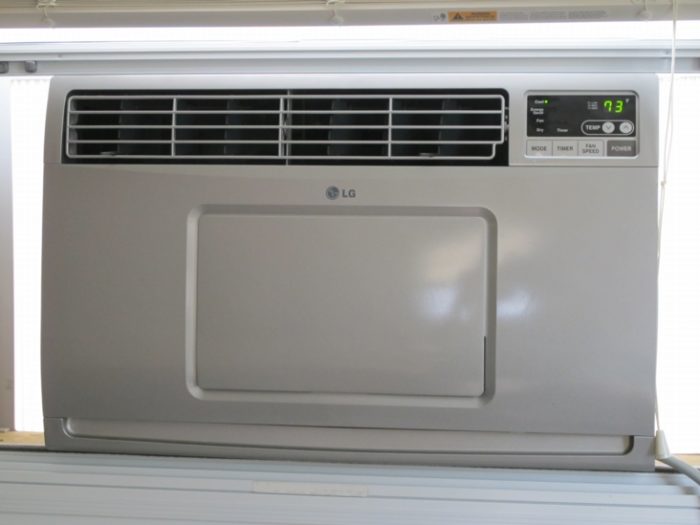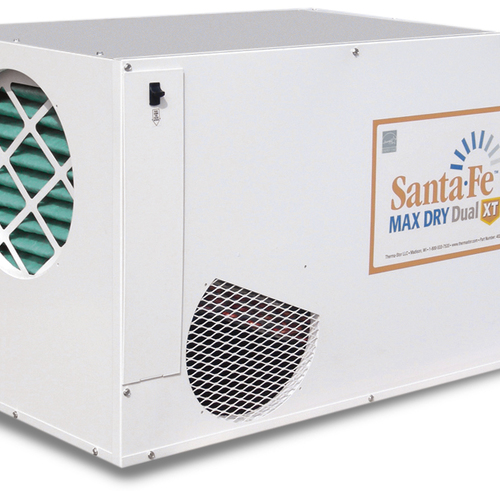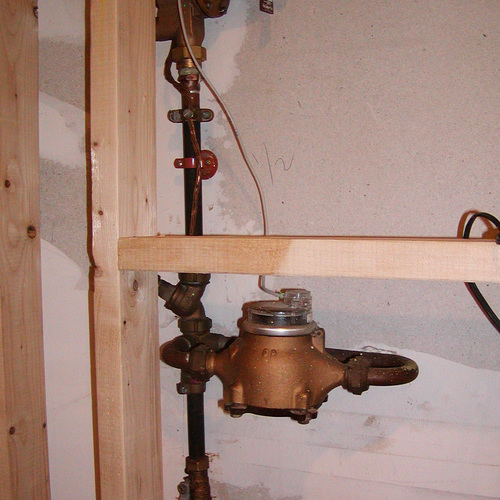Image Credit: Alex Wilson
Last week, I addressed strategies for controlling moisture sources in homes during the summer — one of the contributors to discomfort during hot humid summers. This week, I’ll examine how to remove unwanted humidity using air conditioning equipment, starting with some fundamentals.
To understand moisture removal, it’s important to brush up on a bit of physics. Air is able to hold only a finite amount of water vapor, and that amount is governed by the temperature of the air.
Warm air can hold more moisture than cool air. This is why water droplets appear on that cold glass of iced tea: the outer surface of the glass is cold so the air close to the glass cools off and the amount of moisture it can hold drops. When that air temperature cools to the “dew point,” it means that 100% “relative humidity” is reached; as it cools further, water vapor in that air “condenses” out as liquid water. (Relative humidity is the amount of water vapor in air, expressed as a percentage of the total amount of water vapor that air could hold at that temperature.)
The higher the relative humidity of the air, the higher the dew point temperature. On a really dry day (low relative humidity), not much condensation will form on that glass of iced tea, while on a day with 90% relative humidity, condensed water will drip down the glass and pool on the table it’s sitting on.
All this is important to know, relative to moisture removal, because that’s exactly how most mechanical air conditioning systems work. (I’ll cover dehumidifiers next week.) Copper coils in these systems carry cold refrigerant (heat-transfer fluid), and as household air is blown past these coils, moisture from the air condenses onto the coils and is captured.
Air conditioners and moisture removal
Standard compression-cycle air conditioners (both window units and whole-house models) remove moisture through condensation, as described above. Their effectiveness at moisture removal varies, however. Moisture-removal is reported several ways. On product literature, pints per hour or liters per hour is usually listed. A modest-sized, 12,000 Btu air conditioner, for example, such as the LG model in the BuildingGreen office that’s pictured here, typically removes between 3 and 4 pints of water per hour. Unfortunately, as the energy efficiency of an air conditioner goes up — higher EER (energy efficiency rating) or SEER (seasonal energy efficiency rating) — the moisture-removal performance usually goes down.
Dehumidification efficacy is also measured by the “sensible heat ratio.” (More terminology, I’m afraid: “sensible heat” refers to energy associated with a change in temperature; “latent heat” refers to energy associated with a change in phase, such as from vapor to liquid — which might not involve much change in temperature.) The sensible heat ratio is the fraction of the total cooling energy used for sensible heat removal. Thus, a sensible heat ratio of 0.8 means that 80 percent of the energy used by the air conditioner goes toward lowering the air temperature, while 20 percent goes toward moisture removal.
Selecting and operating an air conditioner
To achieve comfort in our houses, we need to both lower the air temperature and reduce the humidity. Selecting air conditioning equipment involves considering the desirable balance between sensible heat removal and latent heat removal. In a very humid climate where lowering the humidity is almost as important as lowering the air temperature, a low sensible heat ratio — say 0.75 or lower — makes sense. In highly energy efficient homes, humidity removal is also often more important than cooling (because less unwanted heat gets in), so a low sensible heat ratio makes sense — or even a dehumidifier, which usually provides no actual cooling.
Success with air conditioning and moisture removal also involves equipment sizing and operation — it gets pretty complicated. If an air conditioner is oversized, it will operate for only short periods of time, and that will reduce the moisture removal performance. The ideal is to have the equipment sized so that it will operate fairly continuously during peek cooling periods — rather than switching on and off frequently.
It also improves moisture removal to operate air conditioners on a lower setting. Blowing air across the coils more slowly increases moisture removal, so if you’re buying a new unit, look for a model with variable cooling output (or a high moisture-removal setting).
An air conditioner technician or mechanical engineer will help you choose the right product for your situation. He or she will considerable the variables (climate, moisture sources, cooling loads, etc.) and suggest a solution that makes sense.
Don’t forget that less you use an air conditioner, the lower your energy bills, so pay attention to the simple strategies for reducing cooling loads and controlling moisture that I’ve covered in the past two weeks.
* * *
In addition to this Energy Solutions blog, Alex writes the weekly blog on BuildingGreen.com: Alex’s Cool Product of the Week, which profiles an interesting new green building product each week. You can sign up to receive notices of these blogs by e-mail—on the BuildingGreen.com blog page enter your e-mail address in the upper right corner.
Alex is founder of BuildingGreen, LLC and executive editor of Environmental Building News. To keep up with his latest articles and musings, you can sign up for his Twitter feed.
Weekly Newsletter
Get building science and energy efficiency advice, plus special offers, in your inbox.
















One Comment
dehumidification
Great article. Really helpful to learn the ins and outs of how to optimize an air conditioner for moisture removal. You mentioned that a dehumidifier did little or no cooling.
My experience (and understanding of physics) says that it adds considerable heat to the room it is in.
As I use one or two in my basement, and cooler is nicer than warm in the summer, I wonder how the cost effectiveness of the dehumidifier compares to the a c for moisture removal.
Looking forward to next week's article.
Cheers, David
Log in or create an account to post a comment.
Sign up Log in